AVON — Steven R. Bell, 56, passed away peacefully at his daughter’s home in Mystic, Conn., on March 20, 2012. Steven (Sam) was born in Bemidji, Minn., on July 4, 1955 to Clyde and Laverne Bell. After graduating from high school in 1973, Sam joined the U. S. Navy,and served 20 years as a Seabee […]
Obituaries | Full Article
A new season brings some changes to Ocracoke businesses By CONNIE LEINBACH
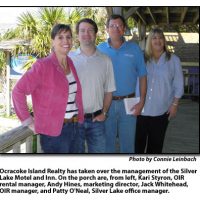
The sounds of spring—hammering and sawing—are in the air on Ocracoke, and visitors will notice some changes in island businesses. George and Janille Turner have been busy the last couple of months giving a facelift to their new restaurant, the Topless Oyster, along Irvin Garrish Highway in the former Jimmy’s Buffet, which had been Captain […]
Local News | Full Article
Do you ever wonder how much rainfall you received from a recent thunderstorm? How about snowfall during a winter storm? If so, then a new volunteer weather observing program needs your help! The Community Collaborative Rain, Hail, and Snow network, or CoCoRaHS, is looking for new volunteers across Eastern North Carolina. The grassroots effort is part of a growing national network of home-based and amateur rain spotters with a goal of providing a high density precipitation network that will supplement existing observations. CoCoRaHS came about as a result of a devastating flash flood that hit Fort Collins, Colo., in July, 1997. A local severe thunderstorm dumped over a foot of rain in several hours while other portions of the city had only modest rainfall. The ensuing flood caught many by surprise and caused $200 million in damages. CoCoRaHS was born in 1998 with the intent of doing a better job of mapping and reporting intense storms. As more volunteers participated, rain, hail, and snow maps were produced for every storm showing fascinating local patterns that were of great interest to scientists and the public. North Carolina became the 21st state to establish the CoCoRaHS program in 2007, and by 2010, the CoCoRaHS network had reached all 50 states with 8,000 to 10,000 observations being reported each day. Through CoCoRaHS, thousands of volunteers, young and old, document the size, intensity, duration and patterns of rain, hail and snow by taking simple measurements in their own backyards. Volunteers may obtain an official rain gauge through the CoCoRaHS website (http://www.cocorahs.org ) for about $27 plus shipping. Besides the need for an official 4-inch plastic rain gauge, volunteers are required to take a simple training module online and use the CoCoRaHS website to submit their reports. Observations are immediately available on maps and reports for the public to view. The process takes only five minutes a day, but the impact to the community is tenfold. By providing high quality, accurate measurements, the observers are able to supplement existing networks and provide useful results to scientists, resource managers, decision makers, and other users. “North Carolina has the most complex climate in the eastern U.S.,” said Ryan Boyles, state climatologist and director of the State Climate Office, based at North Carolina State University. “Data gathered from CoCoRaHS volunteers are very important in better understanding local weather and climate patterns.” “An additional benefit of the program to the National Weather Service is the ability to receive timely reports of significant weather (hail, intense rainfall, localized flooding) from CoCoRaHS observers that can assist forecasters in issuing and verifying warnings for severe thunderstorms,” says David Glenn, CoCoRaHS state coordinator and meteorologist with the National Weather Service in Newport/Morehead City. How does one become a CoCoRaHS observer? Go to the CoCoRaHS website and click on the “Join CoCoRaHS” emblem on the upper right side of the main website. After registering, take the simple online training, order your 4-inch rain gauge and start reporting! “We are in need of new observers across the entire state. We would like to emphasize rural locations and areas near the coast, especially on barrier islands,” added Glenn. FOR MORE INFORMATION To watch a short video on the CoCoRaHS program, go to http://youtu.be/M5-XXg9M30.
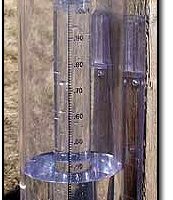
Do you ever wonder how much rainfall you received from a recent thunderstorm? How about snowfall during a winter storm? If so, then a new volunteer weather observing program needs your help! The Community Collaborative Rain, Hail, and Snow network, or CoCoRaHS, is looking for new volunteers across Eastern North Carolina. The grassroots effort is […]
Local News | Full Article
He soon met his first prospective mate, Luna, a white pony who will hopefully soon be carrying his foal. It is hoped that this foal, and others like it, will carry on the heritage and history of Ocracoke’s beloved wild ponies. FOR MORE INFORMATION You can see a video about Alonso’s trip to Ocracoke at http://www.youtube.com/watch?v=gSbzE7gdInc&feature=share For more information, go to the Corolla Wild Horse website at: http://www.corollawildhorses.org/ or for information about the Ocracoke ponies, go to http://www.nps.gov/caha/historyculture/ocracokeponies.htm.
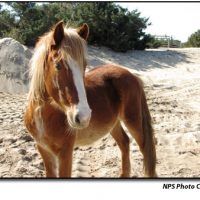
By PAT GARBER The wild ponies of Ocracoke Island and Corolla have been an important part of Outer Banks heritage for centuries. Separated by two major inlets and a distance of more than 100 miles, the two herds have, until now, had no contact with each other. That changed in February when the National Park Service, which […]
Local News | Full Article
55 brave islanders get their heads shaved for a worthy cause…WITH SLIDE SHOW By JOY CRIST
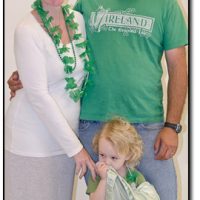
CLICK HERE TO VIEW SLIDE SHOW CLICK HERE TO VIEW SLIDE SHOW (IPad, IPhone and other non-flash compatible device users)
He soon met his first prospective mate, Luna, a white pony who will hopefully soon be carrying his foal. It is hoped that this foal, and others like it, will carry on the heritage and history of Ocracoke’s beloved wild ponies. FOR MORE INFORMATION You can see a video about Alonso’s trip to Ocracoke at http://www.youtube.com/watch?v=gSbzE7gdInc&feature=share For more information, go to the Corolla Wild Horse website at: http://www.corollawildhorses.org/ or for information about the Ocracoke ponies, go to http://www.nps.gov/caha/historyculture/ocracokeponies.htm.

By PAT GARBER The wild ponies of Ocracoke Island and Corolla have been an important part of Outer Banks heritage for centuries. Separated by two major inlets and a distance of more than 100 miles, the two herds have, until now, had no contact with each other. That changed in February when the National Park Service, which […]
Local News | Full Article
Killing animals to save animals – the 2011 report
Last year the National Park Service removed 56 percent fewer predators from the Cape Hatteras National Seashore than it did in 2010. In 2011, according to the Park Service predator management summary, a total of 263 targeted species were removed. That is considerably fewer than the 594 that were removed last year. The animals trapped […]
Editor’s Blog | Full Article
Outer Banks Angling: March madness By ROB ALDERMAN
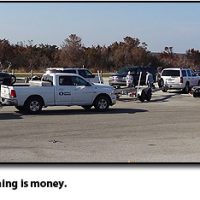
When I talk about March madness, I am not referring to basketball. I am talking about the overwhelmingly beautiful weather. Since my article late week, the daily average high temperature has been in the mid-60s. And the current seven-day forecast shows more of the same. March is known to go either way in its weather. […]
Local News | Full Article
Dredging improves shoaling in Hatteras ferry channel, and more is planned BY CATHERINE KOZAK
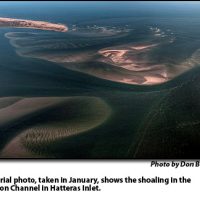
BY CATHERINE KOZAK BY CATHERINE KOZAK As the dredge Merritt chugged away from Hatteras yesterday after 14 days working in Rollinson Channel, conditions in the ferry passage, at least for now, had considerably improved. And after next week, they should be getting even better. Shoaling created by Hurricane Irene in late August had created hazardous […]
Local News | Full Article
Local catch movement picks up steam By KIRK ROSS Coastal Review Online
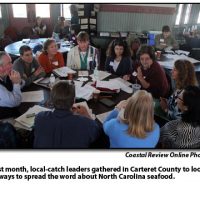
Coming up with a catchy name has been the easy part. Fishing families in North Carolina have faced plenty of challenges in the past few decades — from adapting to tighter regulations to heavy competition from foreign fishing fleets and farmed products. For leaders in the state’s growing local-catch movement, which aims to keep North […]
Local News | Full Article



